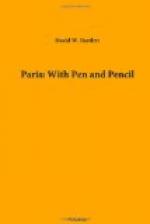I will not give a precise description of the Louvre, but record the things which struck me most forcibly.
The foreigner by showing his passport is admitted any day into the Louvre, though certain days are specified for the public to enter, and upon others the artists of Paris are busy in studying and copying the works of the masters.
[Illustration: THE LOUVRE.]
It was one of those days, when the Louvre was occupied by the artists, that I presented my American passport at one of the entrances, and was politely invited to pass in. My companion was a French artist, who had kindly offered to guide me over the renowned collection of paintings. The visit was much pleasanter to me from the fact that no crowd of visitors was present, and it was a novel sight to behold the young artists of Paris engaged in their work. I have mentioned in another part of this book that no pictures of living artists are allowed a place in the Louvre. The Luxembourg Gallery is the place for all such, and the Louvre collection is therefore made up of paintings from the hands of all the old masters. It is for this reason that the Parisian artists fill the rooms of the Louvre so constantly—either to copy some gem in the vast collection, or by practice, to catch some of the genius of the master-hand.
The first picture-room we entered is represented to be the finest for the exhibition of pictures in the world. Its splendor was really very great. The pictures in it are of immense size, and they require a strong and clear light. It is called the Grand Saloon, and is divided by projecting arcades which are supported by fine marble columns. The length is one thousand three hundred and twenty-two feet, and the breadth forty-two feet. The ceilings and the walls are completely covered by pictures, the number of them being one thousand four hundred. Those by French masters number three hundred and eighty, by the Flemish and German five hundred and forty, and by the Italian four hundred and eighty. The greater part of the collection was made by Napoleon, and though many of the finest pictures were taken away by the allies in 1815, yet it is still one of the largest collections in the world. To stand in this room and gaze at leisure upon some of the finest paintings in the world, was a delight I had never before felt. It is indescribable, yet it was none the less real. I could not, as my friend the artist did, point out the peculiar excellences of each, and the faults, nor compare one with another critically, but I could feel the same thrill of pleasure which he did, and I found that the picture which he declared to be the finest, was that before which I delayed longest. It certainly is no more necessary for a man to be an art-critic to love pictures, than it is to be a botanist to love flowers. I admit that one must be a critic, to a degree, to thoroughly appreciate the art of painting, but that is another thing. The common people in France are universally




